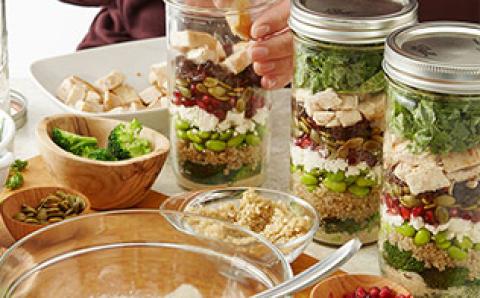How to Plant an Indoor Herb Garden
January 2025

HERE ARE SOME tips FOR CREATING a beautiful, bountiful garden.
What to Plant
Herbs are made to be eaten. Choose the plants you like to use in your favorite recipes, but why not add an herb you’ve always wanted to try?
- Basil, rosemary, parsley and thyme are great go-to herbs for every occasion
- Why not try something fun, such as dill, tarragon or chervil?
- Plant herbs together that need the same conditions—basil and tarragon need more water than rosemary and sage
- Don’t forget flowers—many flowers, such as pansies and marigolds, are edible and actually act as natural pest repellents
- Herb seedling plants are easy to find and ready to go, great for the beginner and those who want an instant garden
- Seed planting is less expensive and offers more of a variety of plants, but seeds need a little more care to get started and will take a little longer to mature
Sunlight
Many herbs used for cooking come from the sunny Mediterranean, so sunlight is essential. Here are some things to consider.
- Pick a spot where the herbs can get at least 6–8 hours of sunlight per day
- A south-facing window is the best spot for maximum sunlight
- If your herbs are growing long, spindly stems and very few leaves, your plant is not getting enough light
Soil
How you plant is as important as what you plant. Here’s what to use.
- Indoor container gardens thrive best in potting mix instead of soil—potting mix is made of organic peat or compost and made to give indoor plants the nutrients and drainage they need
- The growing medium should always be light and crumbly, not sticky
- Crush some eggshells and add them to soil as a natural fertilizer
Water
Overwatering is the biggest mistake people make when growing indoor herbs, so here are a few tips.
- Let the herbs dry out almost completely before watering them again
- Stick your finger in the dirt into the root system to check for dampness
- If you can, place the herbs in the sink to give them a good soaking and water them where the stem meets the dirt, not the leaves, then let them drain well and place them in their sunny home
- Yellow leaves are a sign of too much water, and brown leaves are a sign of not enough
How to Harvest
Harvest your herbs often to encourage growth.
- Never harvest more than a third of your plant to keep it growing
- Discourage the blooming of herb flowers, which change the taste of your herbs, and snip them with scissors as they appear
- Harvest the oldest stems first with scissors to encourage new growth
- Fertilize your herbs more often if you are snipping leaves regularly
How to Use
Here are a few ways to use your new herb garden.
- Chive: It is easy to grow and great on eggs and as a garnish for any dish—try it in our Fluffy Quiche with Chicken
- Parsley: It doesn’t need much sun and goes with any dish—it is great in our Bulgur and Turkey Stuffed Zucchini
- Oregano: It needs a lot of light and is terrific in spaghetti sauce, on pizza, and on chicken with lemon, such as Lemon Oregano Chicken Kebabs
- Thyme: It needs a lot of light and has a lemony flavor that is great in soups and sauces, or Sheet Pan Roasted Chicken and Vegetables
- Basil: It needs lots of water and light and is best when added at the end of cooking or used fresh with tomatoes and mozzarella, as in our Balsamic Grilled Chicken Caprese Salad
Interesting Fact: We put oregano in our chickens’ water and thyme in their all-vegetarian feed to support their immune system so we don’t have to add antibiotics to their diet.
Other
Flavors

Get Your Wine Pairings on Point
January 2025

Fan Favorites for the Big Game
October 2024

Veggi-licious Recipes
January 2025
Reserve your seat at The Table
Subscribe




.jpg?crop=yes&w=480&h=298&itok=bsEZ7f2-)


